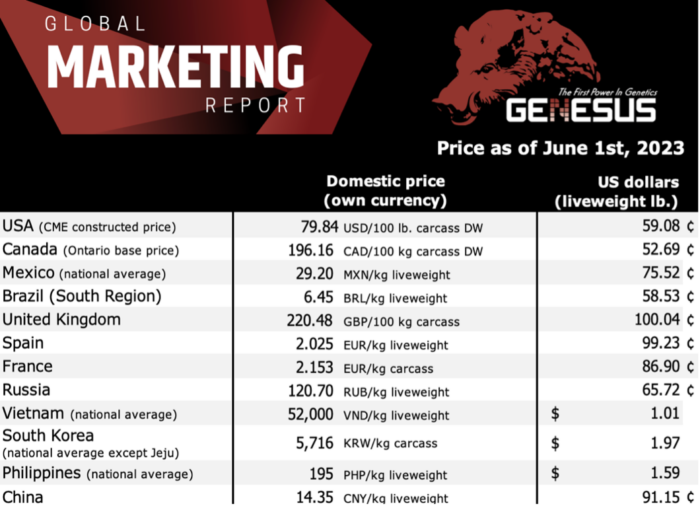Philippe Mallétroit – Director for France

Hog Market : stable prices
After having dropped by 0.227 € since last 3rd of April, the hog market price has stabilized at 2.153 € per kg carcass. During this period there were 5 holidays and therefore for several weeks the slaughterings were reduced to 4 days of killing per week instead of 5 days usually. Last week, 373 988 market pigs have been slaughtered, that’s means the second highest volume of pigs slaughtered this year after the first week of January. This Thursday, 1st of June, a slight increase of 0.2 cts per kg (2.155 €/kg) is recorded.
Prices should continue to increase due to the season, but also due to lack of pigs available, between -4 to -5 % year to date.
Labour is a big challenge
In France, family farming is the predominant model in pig production. In the 80s, the typical model was a farrow-to-finish farm with 56 sows, before to evolved to a model with 112 sows. Nowadays, the farrow-to-finish farms have an average of 230 sows, what is very small compared to many other countries where pig farms are much bigger, most of the time specialized and integrated.
Nevertheless today, with larger farms than in the past, many pig producers have one or several employees in their farm. According to Agreste, in 2018 in France there were 12,700 people working in pig farming, including 5,990 employees. Livestock workers therefore account for almost half of the national pig production workforce.
Labour is therefore a key factor in the success and especially the sustainability of our farms but unfortunately the farms are struggling to recruit employees.
There are about 500 jobs in pig production that appear every year in Brittany (Brittany is the main region of pig production in France, about 60 %). According to ANEFA Bretagne, the average time to fill an offer would be more than 3 months. This obviously leads to difficulties on a day-to-day basis in many farms in short staffing levels : on quality of work but also on the morale of overburdened employees and producers.
These problems are even more present in regions other than Brittany, where pig density is lower, with fewer candidates.
What may be the reasons for this? Lack of attractiveness (hardship, weekend work, etc.)? Generational fracture due to a lack of knowledge of the profession? Change in society’s expectations*?
* According to an IFOP study published this year, work would occupy a less central place in the life of the French, those who can would prefer to earn less but have a little more free time.
Food for thought
The major challenge is to manage the shortage of livestock workers. We do not claim to have all the solutions, but these few avenues can lead to reflection:
- Simplifying work : equipment or technologies easy to use and usable by all. Many times some High-Tech equipments or technologies are too complicate to use by the producers and their employees. What’s more annoying when your automatic feed distribution system breaks down and you can’t get the missing part or service intervention in a short time.
Nevertheless, some technologies are very practical and greatly facilitate the daily work in pig farms (washing robot, automatic pig sorting technology …)
- Robust pigs easy to work with
Is it motivating for an employee to have to remove dead pigs from pen every day? Is it motivating for an employee to have to constantly treat pigs due to ear biting or tail biting ? Is it motivating for an employee to have to isolate weak sows with legs problem before they die ? Is it motivating for an employee to have to use a lot of nursing sows by removing piglets from their mother due to lack of milk production ? The answer is obviously no. It is not motivating for anyone to go to work with these daily problems.
Genetics is the main reason of these problems. At Genesus, we have robust, strong and easy pigs to manage. That’s makes a big difference and leads the work easier.
- Animal welfare
Animal welfare rules already exist and will continue to develop more and more in France and Europe. The goal is not to express an opinion on this subject, but rather to listen to the opinion of those who are confronted with it on a daily basis, like pig producers and their employees.
A few sentences heard here and there :
“With the new Welfare protocol rules to castrate piglets we spend even more time than before.”
“If in a near future we will have to use straw for the sows, as it is already the case in some other Europeans countries, manure management will become a problem.”
“Animal welfare is a good thing, but who thinks of the welfare of the pig producers?”
There is no doubt that there can be no sustainable development if these new welfare rules (costs) do not improve the profitability of the farms by creating more workload.
Source : Marché du Porc Breton, Travailler en élevage porcin : facteurs d’attractivité et contraintes C DEPOUDENT, N HOSTIOU, L LE CLERC (JRP 2021), ANEFA
Categorised in: Featured News, Global Markets
This post was written by Genesus



